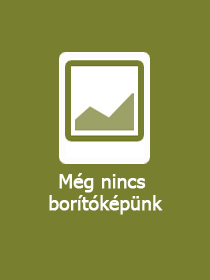
The Routledge Handbook of Content and Language Integrated Learning
Sorozatcím: Routledge Handbooks in Applied Linguistics;
-
10% KEDVEZMÉNY?
- A kedvezmény csak az 'Értesítés a kedvenc témákról' hírlevelünk címzettjeinek rendeléseire érvényes.
- Kiadói listaár GBP 47.99
-
24 287 Ft (23 131 Ft + 5% áfa)
Az ár azért becsült, mert a rendelés pillanatában nem lehet pontosan tudni, hogy a beérkezéskor milyen lesz a forint árfolyama az adott termék eredeti devizájához képest. Ha a forint romlana, kissé többet, ha javulna, kissé kevesebbet kell majd fizetnie.
- Kedvezmény(ek) 10% (cc. 2 429 Ft off)
- Discounted price 21 859 Ft (20 818 Ft + 5% áfa)
24 287 Ft

Beszerezhetőség
Még nem jelent meg, de rendelhető. A megjelenéstől számított néhány héten belül megérkezik.
Why don't you give exact delivery time?
A beszerzés időigényét az eddigi tapasztalatokra alapozva adjuk meg. Azért becsült, mert a terméket külföldről hozzuk be, így a kiadó kiszolgálásának pillanatnyi gyorsaságától is függ. A megadottnál gyorsabb és lassabb szállítás is elképzelhető, de mindent megteszünk, hogy Ön a lehető leghamarabb jusson hozzá a termékhez.
A termék adatai:
- Kiadás sorszáma 1
- Kiadó Routledge
- Megjelenés dátuma 2025. május 27.
- ISBN 9781032001968
- Kötéstípus Puhakötés
- Terjedelem568 oldal
- Méret 246x174 mm
- Súly 453 g
- Nyelv angol
- Illusztrációk 13 Illustrations, black & white; 3 Halftones, black & white; 10 Line drawings, black & white; 190 Tables, black & white 700
Kategóriák
Rövid leírás:
Divided into six sections, covering language and language teaching, core themes and issues, contexts and learners, CLIL in practice, CLIL around the world and a final section looking forward to future research directions, every chapter provides a balanced discussion of the benefits, challenges and implications of this approach.
TöbbHosszú leírás:
Content and language integrated learning (CLIL) is an increasingly popular educational approach given its dual focus on enabling learners to acquire subject-matter through an additional language, while learning this second language in tandem with content. This Handbook provides a comprehensive overview of recent CLIL developments, illustrating how CLIL has been uniquely conceptualised and practised across educational and geographical contexts.
Divided into six sections, covering language and language teaching, core topics and issues, contexts and learners, CLIL in practice, CLIL around the world, and a final section looking forward to future research directions, every chapter provides a balanced discussion of the benefits, challenges and implications of this approach. Representing the same diversity and intercultural understanding that CLIL features, the chapters are authored by established as well as early-career academics based around the world.
The Routledge Handbook of Content and Language Integrated Learning is the essential guide to CLIL for advanced students and researchers of applied linguistics, education and TESOL.
Capturing the multifaceted nature of CLIL, this Handbook spans levels of education and linguistic, geographical and socio-political contexts. It is a timely synthesis of CLIL research and practice, with perceptive insights for future development. This comprehensive handbook will be a valuable resource for CLIL researchers and teachers alike.
-- Tarja Nikula, University of Jyväskylä, Finland
With its impressive range of topics covered by leading scholars in CLIL, this Handbook will be a crucial and valuable source of relevant knowledge and cutting-edge thinking, and a treasured resource for students, researchers, teacher educators and last, but far from least, teachers engaged in bilingual education.
-- Ute Smit, University of Vienna, Austria
TöbbTartalomjegyzék:
List of figures
List of tables
List of contributors
Acknowledgments
Introduction
Darío Luis Banegas and Sandra Zappa-Hollman
PART 1
Language and language teaching in CLIL
1 CLIL and linguistics
Ana Llinares
2 Translanguaging in CLIL
Pat Moore
3 CLIL and language teaching approaches
Raul Albuquerque Paraná, Sávio Siqueira and Julia Landau
4 CLIL and English for specific purposes
Gabriela Tavella and Soledad Loutayf
5 CLIL and English-medium instruction
Joyce Kling and Slobodanka Dimova
6 Epistemological and methodological trends in CLIL research
José Goris
PART 2
Core topics and issues
7 CLIL and educational policy
Yolanda Ruiz de Zarobe
8 L2 proficiency and development in CLIL
Christiane Dalton-Puffer and Silvia Bauer-Marschallinger
9 Cognitive development in CLIL
Alberto Fernández-Costales
10 Intercultural citizenship as CLIL in foreign language education
Melina Porto
11 CLIL and professional development
Limin Yuan and Yuen Yi Lo
12 Collaboration between CLIL teachers
Josephine Moate
PART 3
Contexts and learners
13 CLIL with heritage languages
Joanna McPake
14 CLIL with languages other than English
Kim Bower
15 Doing CLIL with primary learners: From principles to practice
Fabiana Fazzi and Marcella Menegale
16 CLIL with secondary school learners
Veronico N. Tarrayo and Philippe Jose S. Hernandez
PART 4
CLIL in practice
17 Teachers? perceptions, beliefs, and attitudes on CLIL
Jermaine S. McDougald
18 The learner?s perspective on CLIL: Attitudes, motivations, and perceptions
Xabier San Isidro and María Luisa Pérez Ca?ado
19 Instructional scaffolding in CLIL: An overview of theory and research
Karina Rose Mahan
20 Classroom interaction in CLIL
Dongying Li
21 CLIL challenges in designing learning experiences
Liz Dale and Tessa Mearns
22 CLIL materials: From theory to practice
Laura Karabassova and Nurziya Oralbayeva
23 Corrective feedback in CLIL
Ruth Milla and Pilar García Mayo
24 Assessment in CLIL
Takanori Sato
PART 5
CLIL around the world
25 CLIL in various forms around the world
Liss Kerstin Sylvén and Keiko Tsuchiya
26 CLIL in the Nordic countries
Sotiria Varis and Anssi Roiha
27 CLIL in The Netherlands: Three decades and innovation and development
Tessa Mearns, Evelyn van Kampen, and Wilfried Admiraal
28 CLIL in Italy
Jacqueline Aiello and Emilia Di Martino
29 CLIL in Ecuador
Juanita Argudo, Tammy Fajardo-Dack, and Mónica Abad
30 CLIL in Colombia
Kathleen A. Corrales and Paige M. Poole
31 The CLIL experience in Cameroon
Innocent Mbouya Fassé and Alain Flaubert Takam
32 Current practice and research of CLIL in Japan
Chantal Hemmi
33 CLIL in Taiwan
Wenhsien Yang
PART 6
Looking forward
34 CLIL: Critical perspectives
Bong-gi Sohn
35 CLIL: Future directions
Tom Morton
36 Coda: Carpe diem
Do Coyle
Index
Több








